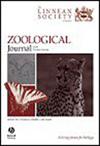Integrative taxonomy reveals further hidden diversity of Marphysa (Polychaeta: Eunicidae) in European Atlantic and Mediterranean waters
IF 2.8
2区 生物学
Q1 ZOOLOGY
引用次数: 0
Abstract
Marphysa (Polychaeta: Eunicidae) is represented in the Mediterranean by M. aegypti, M. birgeri, and M. chirigota. Previous reports of M. sanguinea are doubtful, because it has a confirmed distribution around the southern English coasts (NE European Atlantic). In this study, we combine morphological and molecular (using 16S rDNA and cytochrome c oxidase I) analyses to reveal for the first time the presence of M. gaditana in the NW Mediterranean (Gulf of Tunis, Tunisia) and to substantiate its presence along the Atlantic coasts of France—previously relying solely on molecular data—drawing on specimens collected in Arcachon Bay and Oléron Island. Our findings also allow us to describe a new species of Marphysa from the Mediterranean coasts of southern France, namely Marphysa gili Martin and Romano, sp. nov., based only on morphological data. Our research highlights previously overlooked diversity within Marphysa on Atlantic and Mediterranean European coasts, thus contributing to the growing series of recent rigorous taxonomic studies that are challenging the historical tendency to merely report ‘M. sanguinea’ without a thorough taxonomic examination or when undertaking physiological, reproductive, or resource management studies on ‘M. sanguinea’ without questioning the appropriateness of using this species’ name.综合分类进一步揭示了欧洲大西洋和地中海水域Marphysa(多毛目:蠓科)的多样性
Marphysa(多毛目:蚊科)在地中海以埃及伊蚊、伯氏伊蚊和chirigota伊蚊为代表。先前关于血支原体的报告是可疑的,因为它在英国南部海岸(欧洲大西洋东北部)有一个确定的分布。在这项研究中,我们结合形态学和分子(使用16S rDNA和细胞色素c氧化酶I)分析,首次揭示了M. gaditana在地中海西北部(突尼斯突尼斯湾)的存在,并证实了它在法国大西洋沿岸的存在-以前仅依赖于在Arcachon湾和olacimron岛收集的标本的分子数据。我们的发现还允许我们仅根据形态学数据描述来自法国南部地中海沿岸的Marphysa新种,即Marphysa gili Martin和Romano, sp. nov.。我们的研究突出了以前被忽视的大西洋和地中海欧洲海岸Marphysa的多样性,从而促进了最近一系列严格的分类学研究,这些研究挑战了仅仅报告“M”的历史倾向。在没有进行彻底的分类学检查或进行生理,生殖或资源管理研究的情况下,对‘ M ’进行研究。在不质疑使用该物种名称的适当性的情况下,将其命名为Sanguinea。
本文章由计算机程序翻译,如有差异,请以英文原文为准。
求助全文
约1分钟内获得全文
求助全文
来源期刊
CiteScore
6.50
自引率
10.70%
发文量
116
审稿时长
6-12 weeks
期刊介绍:
The Zoological Journal of the Linnean Society publishes papers on systematic and evolutionary zoology and comparative, functional and other studies where relevant to these areas. Studies of extinct as well as living animals are included. Reviews are also published; these may be invited by the Editorial Board, but uninvited reviews may also be considered. The Zoological Journal also has a wide circulation amongst zoologists and although narrowly specialized papers are not excluded, potential authors should bear that readership in mind.

 求助内容:
求助内容: 应助结果提醒方式:
应助结果提醒方式:


